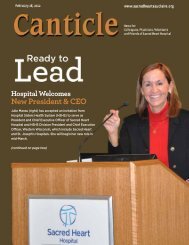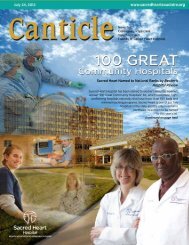August 19, 2011.indd - Sacred Heart Hospital
August 19, 2011.indd - Sacred Heart Hospital
August 19, 2011.indd - Sacred Heart Hospital
Create successful ePaper yourself
Turn your PDF publications into a flip-book with our unique Google optimized e-Paper software.
Click here to find out more!<br />
Joe Cantlupe, for HealthLeaders Media , <strong>August</strong> 15, 2011<br />
<strong>Hospital</strong>s are finding that multidisciplinary approaches in spine care, with partnerships among the key<br />
disciplines, are leading to more efficiencies and better patient outcomes.<br />
Indeed, under the umbrella of spine care, hospitals are expanding multidisciplinary approaches in inpatient<br />
and outpatient care for spinal complications such as herniated disks, sciatica, and related conditions.<br />
From minimally invasive techniques to concentrating on specific illnesses such as osteoporosis, health centers<br />
are increasing their varied approaches to meet needs of patients seeking shorter recovery times. The wide<br />
area of spine care runs the gamut for conditions including scoliosis, degenerative issues, and fractures.<br />
While spine procedures are continuing to evolve, hospital officials are dealing with an evolving marketplace<br />
in implants as insurers are rejecting more expensive surgical procedures, and the complexity of spinal<br />
surgeries is undergoing more scrutiny.<br />
Kamal Thapar, MD, medical director of neurosurgery and tertiary care services at the 300-bed <strong>Sacred</strong> <strong>Heart</strong><br />
<strong>Hospital</strong>, in Eau Claire, WI, says pressing financial pressures combined with better ways to serve patients are<br />
prompting healthcare leaders to expand multidisciplinary techniques in spine care, a process traditionally used<br />
more frequently in other service lines, such as cardiology.<br />
At <strong>Sacred</strong> <strong>Heart</strong>, for instance, using multidisciplinary techniques has led to expansion of the service line in<br />
spine care and increased surgical procedures with technological advances, Thapar says. <strong>Hospital</strong>s also are<br />
including technological innovations and specialized surgical suites to provide state-of-the-art treatment for<br />
spine care.<br />
"The whole issue of spine care is huge," Thapar says. "There are an increasing number of people in their 70s<br />
and 80s, living a very intellectually and spiritual life in every other way, except their back pain or other<br />
ailments may not allow them to have the quality of life they are seeking."<br />
At least 31 million Americans experience low-back pain at any given time; and half of all working Americans<br />
claim to have back pain symptoms each year, according to the American Chiropractic Association. Americans<br />
spend at least $50 billion each year on back pain, the association states, with 80% of the population expected<br />
to experience a back problem at some time in their lives.<br />
A study published last year in the Journal of the American Medical Association found that the cost of treating<br />
spine problems in the United States rose 65% in the past decade to $85.9 billion a year, rivaling the economic<br />
burden of cardiology treatment, which is about $89 billion.<br />
Controversies have swirled around spine care, particularly regarding overutilization of surgeries and costs. As<br />
a result of those concerns, some hospitals are opting for more conservative approaches, including chiropractic<br />
programs in their overall spine care program, says Lee Zohn, DC, DAAPM, CCSP, FICPA, director of the<br />
229-bed Winchester <strong>Hospital</strong>'s chiropractic center in Woburn, MA.<br />
The 680-staffed-bed UCSF Medical Center also has incorporated a multidisciplinary approach combining<br />
orthopedic and neuro spine surgeons with radiation oncologists and neuroradiologists in the center's spine care
program which has led to improved outcomes and processes to explore nonsurgical and surgical solutions for<br />
patients, says Eula Mckinney, MsHA, director of general surgery, orthopedics, pain management, and spine<br />
service lines for the UCSF Medical Center in San Francisco. The hospital has streamlined its program for<br />
evaluating implant costs to improve efficiencies.<br />
"We have made great strides to increase the collaboration among the various disciplines by having a common<br />
goal of working in an integrated fashion," Mckinney says.<br />
The multidisciplinary approach has resulted in marked changes in delivery of spine care, particularly among<br />
surgeons.<br />
"There is a different mind-set from what spine surgeons have been so used to; it's been longer in coming. It is<br />
slowly gaining traction; it is long overdue," says Douglas Garland, MD, medical director and chair of<br />
orthopedics and neurosciences at the 162-bed Long Beach (CA) Memorial Medical Center.<br />
Success Key No. 1: Patient management<br />
The 299-bed Methodist <strong>Hospital</strong> in Merrillville, IN, does a comprehensive treatment of spinal disorders with a<br />
multidisciplinary approach through a collaboration of physicians and other clinicians specializing in<br />
neurosurgery, orthopedic surgery, and physical therapy under a program known as Priority Consult. It is a<br />
patient management system that hospital officials say has been implemented to improve productivity and the<br />
patient experience.<br />
A digital technology program has been drawn up to organize and review each patient's medical history,<br />
clinical status, tests, and imaging during the early stage of evaluation for spinal care.<br />
After evaluations are completed, a spinal team can determine the appropriate course of treatment, whether<br />
surgical or not, says Laurel Valentino, RN, CNRN, director of Methodist's neurosciences program. The<br />
process has led to greater efficiencies and patient approval. Since the program has been in effect less than a<br />
year, data is still being compiled, she says.<br />
It was important to develop Priority Consult because although surgical procedures are sometimes necessary,<br />
more than 80% of spine patients are treated without surgical intervention, says Elian Shepherd, MD, the spine<br />
care center medical director.<br />
Under the hospital's program, physicians evaluate patients in preappointment screenings that enable staff to<br />
make evaluations even before an initial appointment. That occurs after a patient or referring physician calls<br />
the spine program's central line for consultation or referral. At that point, an intake specialist captures the<br />
medical history.<br />
"The idea is to get the patient to the right service as soon as possible," says Valentino. "It takes a team<br />
approach to get patients in to see the physicians in a timely manner and also support them. We try to get the<br />
appropriate tests done before the patient sees the doctor so that they can develop a plan of care, with their<br />
needs. Also, patients can call directly if they do not have a physician.<br />
"We think this is the wave of the future," Valentino adds. "We have a kind of virtual center, and with a nurse<br />
navigator we get prior information about the patient that helps the doctors screen them. If it is the highest<br />
priority, a patient gets to see a surgeon right away; if there are onset symptoms, like they cannot walk or have<br />
numbness, they go to the emergency department. If there is a disc issue or some type of herniation, they can<br />
be screened and within three to five days to see a surgeon. If there is no pathology," she adds, "a physical<br />
medicine doctor is seen, and then we get patients on physical therapy and we can build upon that."<br />
The Methodist patient care team includes a physical therapist, an occupational therapist, an orthopedic
surgeon as needed, and a care manager, such as a nurse specializing in neurology, to coordinate the patient<br />
care. The physician assigned to the case is regularly updated from the care coordinator, a nurse who offers<br />
education service and assists with pain management, therapy, or treatment, says Valentino.<br />
"We don't do tests to do tests; the idea is to be more economical. There will be definitely more patients<br />
because of the aging population," Valentino says. "There are more issues with stress on the back, but it's not<br />
only age. Someone may just twist the wrong way, and even younger people have that happen.<br />
"You are bringing a full service to the patient, not just doing the back surgery and sending them out,"<br />
Valentino says. "We are doing medical management and making sure the patient gets the right diagnostic tests<br />
and physical therapy through the multidisciplinary approach." With greater efficiencies, Valentino says the<br />
hospital can handle greater volume. "This is from a holistic standpoint, and as part of those changes, you bring<br />
in more patients, and it is good for the ROI."<br />
Success Key No. 2: Osteoporosis specialty<br />
The Methodist <strong>Hospital</strong> has a spine specialty program, but hospital leadership decided the hospital needed to<br />
specialize further with development of a program for osteoporosis care.<br />
The hospital has begun widespread screenings on bone density for patients on an outpatient basis to determine<br />
if there are any problem areas and alert them to possible treatment. It has designated practitioners and nursing<br />
staff to work specifically on osteoporosis, a disease that is increasing, especially among women. Osteoporosis<br />
—which leads to the weakening and breaking of bones in the spine, hips, or wrists—can be brought on by<br />
minor accidents.<br />
"As physicians we are not paying serious attention to the problem," says Shepherd, referring to osteoporosis.<br />
"The only time we take care of it is when there is a fracture, and at that point we may be very well beyond<br />
the point of an osteoporosis condition."<br />
Because of what Shepherd and other Methodist <strong>Hospital</strong> officials have described as undertreatment of<br />
osteoporosis, the hospital officials have placed key importance on bone scan studies as part of overall care. If<br />
a problem exists, they refer the patient to the spine center for osteoporosis treatment. Such actions can help<br />
the patient properly combat osteoporosis conditions, Shepherd says.<br />
Another important aspect of care is to form continuing relationships between the hospital and the primary<br />
care physicians regarding osteoporosis and improved treatment regimens, Shepherd says. "We have a nurse<br />
dedicated for follow-up care," Shepherd says. "We see patients who are admitted for other conditions, but<br />
with a bone evaluation, we make them aware of the problem. We are definitely seeing more of these<br />
osteoporosis cases than in the past as a result of degenerative changes affecting the spine. People come into<br />
the hospital stooped or standing with a stoop, having lower-back issues." Kristy Darnell, MSN, APN, FNP, an<br />
advanced nurse practitioner and care coordinator for the hospital, says Methodist officials are working to<br />
educate female patients about the necessity for prompt treatment of the condition, especially at a younger<br />
age. "We are getting them screened and making sure they are receiving early treatment," Darnell says.<br />
An estimated 10 million Americans over age 50 have osteoporosis, the most common bone disease, while<br />
another 34 million are at risk, the according to the U.S. Surgeon General. Each year, an estimated 1.5 million<br />
people suffer an osteoporotic-related fracture, an event that often leads to a downward spiral in physical and<br />
mental health.<br />
"Due primarily to the aging of the population and the previous lack of focus on bone health, the number of<br />
hip fractures in the United States could double or even triple by the year 2000," a Surgeon General's report
states.<br />
Once patients are advised about osteoporosis conditions, "patient adherence to treatment is another problem<br />
that must be overcome," Shepherd says.<br />
Success Key No. 3: Chiropractic options<br />
The Winchester <strong>Hospital</strong> has a spine service center that includes surgery programs. But it also incorporates an<br />
option that has led to greater ROI and more patient involvement: chiropractic care. The hospital emphasizes a<br />
conservative approach within its orthopedic system for improved patient volumes and outcomes, says Zohn,<br />
director of the chiropractic center.<br />
Winchester is among a growing number of hospitals incorporating chiropractic units in the hospital, says<br />
Zohn.<br />
The model enables hospital leadership to overcome concerns that there may be too many spine-related<br />
surgeries.<br />
"People in communities where they have easy access to MRIs have significantly more back surgeries than<br />
those who don't," Zohn says. "But we feel that this approach is good because conservative approaches and<br />
treatment need to be eliminated first as a possibility before surgery. We do a lot of spine surgeries in this<br />
country, from herniated discs to generative disc disease. A lot of money is spent on this, but it needs to be<br />
cost effective."<br />
At least 10,000 patients visits have occurred at the off-site location for chiropractic care in each of the past<br />
several years, Zohn says. The chiropractic center ranks among the highest in patient satisfaction scores in all<br />
hospital units, he adds.<br />
"Doctors who work within the hospital are very receptive to the program and refer a lot of patients here. It<br />
also goes both ways; the chiropractic clinic refers patients to the hospitals," he says. The hospital<br />
administration has reported patient satisfaction scores in the high 90% range, "one of the highest in the whole<br />
hospital system," Zohn says. "With that satisfaction, it brings more people into the Winchester <strong>Hospital</strong><br />
system."<br />
Chiropractic care often focuses on bulging discs, which indicates problems in the muscular or neurological<br />
areas surrounding spinal structures and joints. A bulging disc itself is not actually painful, but it can be a<br />
musculoskeletal problem that affects other spinal conditions such as spinal stenosis, sciatica, or nerve<br />
compression.<br />
"We've been very busy here with the patient population," Zohn says. "The doctors are seeing a lot of patients,<br />
but the docs want to eliminate the conservative approaches first before the need for surgery. We have<br />
orthopedic surgeons, for anything from tennis elbow to shoulder problems. But I think patients love this; they<br />
want a nonsurgical and drug-free approach to their problems. If there is no other alternative solution, at least<br />
they know about it."<br />
Another key aspect of the hospital's care program includes maintenance, which often has been not fully<br />
realized in spine care, Zohn says. The hospital works to ensure proper follow-up once the patient leaves the<br />
facility, he says.<br />
The federal Agency for Health Care Policy and Research encouraged the "utilization of chiropractic services<br />
for the management of low-back pain, given the impressive body of evidence on the effectiveness and<br />
comparative cost-effectiveness of these services."<br />
Success Key No. 4: Negotiating for implants
Several years ago, the UCSF Medical Center projected a loss of $13.9 million in spinal implant costs. When<br />
Mckinney became director of the spine program, one of her first tasks was to help the healthcare system<br />
unravel the problems. Over time, the complicated spinal implant revenue issues were identified and<br />
simplified, and costs were reduced, she says.<br />
The hospital system worked on a plan that enabled physicians and administrators to work in harmony to<br />
reduce costs under a revised committee implant-purchasing structure, which wasn't always easy or<br />
comfortable, Mckinney says. The hospital system has now reversed its losses and has a competitive price<br />
index better than 83% of hospitals with implants, she says.<br />
In carrying out the plan, a physician champion was identified to help create a formula and organized plans for<br />
negotiating with vendors. A procurement team was identified to evaluate cost and utilization of items,<br />
Mckinney says.<br />
"We assigned the pricing so we would have specific information, have transparency, and share that<br />
information with physicians," she says.<br />
"We discussed opportunities to improve [spending and lowering costs] on some of the higher-cost items,"<br />
Mckinney says. It was important to have an administration and physician team to evaluate working with<br />
vendors, she says. Too often, physicians had worked with vendors to develop their own schedules and<br />
payments, some with the same companies for years.<br />
Once a physician champion was identified, the system created "categories of like cases, and we assigned the<br />
pricing for specific information, and the information was shared with physicians." The spine steering<br />
committee's focus on implant procedures and costs became a central part of the hospital's makeover leading<br />
to cost reductions. For instance, if an implant is discussed and one physician isn't used to the particular item,<br />
"other physicians would speak clinically about how they use it, and talking about what are the greatest<br />
opportunities for savings. The discussion comes down to, 'Is it worth an extra $1,000, or can I use an<br />
alternative implant in lieu of item X?'" Mckinney says.<br />
Success Key No. 5: Imaging technologies<br />
<strong>Sacred</strong> <strong>Heart</strong> <strong>Hospital</strong> decided that it needed to compete with outpatient centers in developing spine<br />
programs. One of the first things it did was hire Thapar as director of the Brain and Spine Institute, and in the<br />
next several years he and hospital leadership expanded the hospital's surgical suites, specifically for brain and<br />
neurological care.<br />
The major element of its program is development of digitally integrated systems that allow the surgeon to be<br />
certain that implants were ideally positioned even before the surgery process has begun. Thapar says the<br />
procedures allow for "instant verification of surgical outcomes" through images for minimally invasive<br />
procedures. By using the imaging system, which includes brain mapping and navigational technology,<br />
surgeons eliminate the need for large and painful incisions required in traditional spine surgery.<br />
By using the programs, the hospital has expanded its surgical program with more practitioners and nurses. The<br />
expanded suites also have resulted in increases in brain and spine surgeries, from 60 in 2003 to 622 in 2009,<br />
Thapar says, an increase that "is very successful."<br />
Thapar says the increases show that "through a wide range of procedures, with a community hospital, if you<br />
have the right talent and technology, you can rival a tertiary care facility."<br />
http://www.healthleadersmedia.com/page-1/MAG-269714/Structuring-a-Spine-Program
















